WHAT IS ORGANIC CHEMISTRY?
Let us start with the question "What is Organic chemistry?".The simple answer is: It is the chemistry of carbon containing compounds, which are otherwise known as organic compounds.
So it is pretty easy to recognize that we should start our journey of organic chemistry by exploring the chemical nature of carbon.
WHAT IS CARBON?
So the next question is: What is carbon?* Carbon is an element with atomic number (Z) = 6.
* Its ground state electronic configuration can be represented as: 1s22s22p2 (or) 1s22s22px12py12pz0

* It is a non metal.
* On Pauling's scale, its electronegativity value is around 2.5.
* It usually forms covalent bonds.
* Its valency is 4 since there are four electrons in the outer shell i.e., it can form four covalent bonds with other atoms.
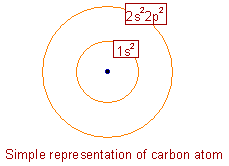
WHY THERE ARE MILLIONS OF ORGANIC COMPOUNDS?
It is well known that there are millions of organic compounds around, which are either originated from the nature or prepared synthetically.Examples of organic compounds include carbohydrates, proteins, enzymes, vitamins, lipids, nucleic acids , synthetic polymers, synthetic fabrics, synthetic rubbers, plastics, medicines, drugs, organic dyes and so on.
Now the immediate question is: Why the carbon atom is so special and forms millions of compounds?
To answer this question, we should know about catenation.
Catenation is the ability of atoms of same element to bond covalently among themselves and form long chains or rings.
Carbon has a stronger tendency to catenate since it is a smaller atom and can form stronger covalent bonds with other carbons. The C-C bonds are stronger due to effective overlapping of atomic orbitals.
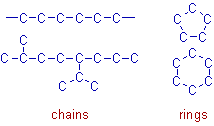
The organic compounds can also exhibit isomerism due to different structural and spatial arrangement of atoms or groups leading to formation of huge array of compounds.
These arguments explain why the carbon can form millions of compounds and organic chemistry is flourishing like nothing.
HOW DOES CARBON FORM CHEMICAL BONDS?
LEWI'S DOT MODEL
Carbon is an appreciably electronegative element and tends to form four covalent bonds by using all the four electrons in its valence shell i.e., the second shell for which the electronic configuration can be written as 2s22p2. Hence the combining power or the valency of carbon is 4. It can form 4 bonds with other atoms.It is possible to understand the bonding in carbon compounds by using Lewi's dot model. According to this model, each atom participating in the bonding contributes one electron to form an electron pair which is shared between the two contributing atoms. Thus a covalent bond is formed. If atoms share two electron pairs, a double bond is formed. And a triple bond is formed when three electron pairs are shared.
The purpose of participating in bond formation is to get the nearest inert gas configuration and thus by getting stability. Most of the atoms try to get eight electrons or octet configuration in the valence shell. This is also called as octet rule.
The structures of some simple organic molecules are explained as shown below.
Methane, CH4: The carbon atom contributes four valence electrons to make four bonds with hydrogen atoms. Each hydrogen also contributes one electron for the bond formation.
Thus there are 4 C-H bonds in the methane molecule and carbon gets octet configuration in the valence shell.
Note that the valency of hydrogen atom is one. It can form only one bond since there is only one electron in this atom. It also gets Helium's configuration during bond formation.
Also note that in Lewi dot models, only the valence electrons are shown. The bond pairs can also be shown by lines.
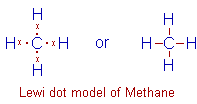
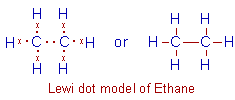


Note that the only the bond pairs are shown as lines in the second representation.
There are three lone pairs and one bond pair around fluorine atom. The bond pair is shown as a line.
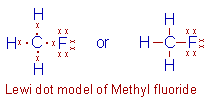
Formaldehyde, CH2O: There are six electrons in the valence shell of oxygen. It forms two bonds by contributing two of its valence electrons and thus by completing the octet. In formaldehyde, the oxygen atom forms two bonds with a carbon atom.
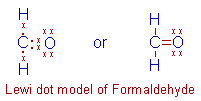
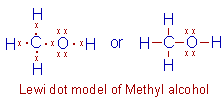

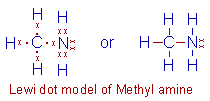
VALENCE BOND THEORY
According to valence bond theory, four unpaired electrons are required to form four covalent bonds. But there are only 2 unpaired electrons in the valence shell of carbon in the ground state.However it is possible to get 4 unpaired electrons by transferring one of the electrons from 2s orbital into the empty 2p orbital. This process is called excitation and carbon is said to be in the excited state. Now the electronic configuration of carbon in the excited state becomes 2s12p3.
A small amount of energy, which is available during the chemical bond formation, is sufficient for a carbon atom to undergo excitation.

However, carbon undergoes hybridization before forming actual chemical bonds with other atoms.
Hybridization is the process of intermixing of two or more pure atomic orbitals of almost same energy to form same number of identical and degenerate new orbitals known as hybrid orbitals.
The carbon atom can undergo three types of hybridizations i.e., sp3 or sp2 or sp.
SP3 HYBRIDIZATION OF CARBON
In sp3 hybridization, one 2s and three 2p orbitals of excited carbon intermix together and form 4 hybrid orbitals which are oriented in tetrahedral geometry in space around the carbon atom. Each sp3 hybrid orbital is occupied by one electron.
E.g. In methane molecule, CH4, the carbon atom undergoes sp3 hybridization and forms four σ-bonds with hydrogen atoms.
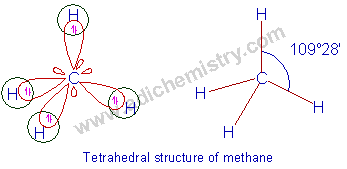
SP2 HYBRIDIZATION OF CARBON
In sp2 hybridization, there is intermixing of one 2s and two of the 2p orbitals of carbon in the excited state to form three hybrid orbitals. These are oriented in trigonal planar geometry. Each sp2 hybrid orbital is occupied by one electron. The remaining pure 2p orbital with one electron lies at right angle to the plane of hybrid orbitals.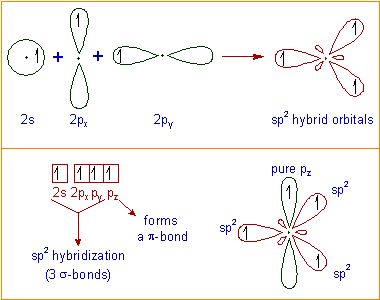
E.g. In ethylene molecule, C2H4, each carbon atom undergoes sp2 hybridization. Each carbon forms 2 σ-bonds with hydrogens and one σ-bond with another carbon. The remaining pure 'p' orbitals on two carbons overlap sidewise to form a π-bond. Thus there is a double bond between two carbons.
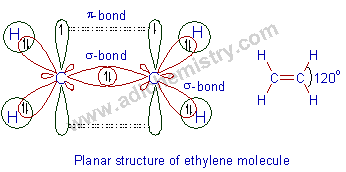
SP HYBRIDIZATION OF CARBON
In sp hybridization, one 2s and one 2p orbitals of excited carbon intermix to form two sp-hybrid orbitals in linear geometry. Each sp hybrid orbital is occupied by one electron. The remaining pure 2p orbitals ( for our convenience, let us say: 2py and 2pz) orient at right angles to the sp-hybrid orbitals. These are also occupied by one electron each.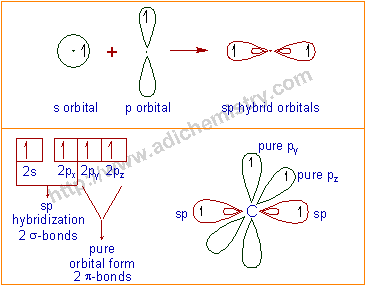
E.g., In acetylene molecule, C2H2, each carbon undergoes sp hybridization and forms one σ-bond with a hydrogen atom and one σ-bond with another carbon. The two carbon atoms also form two π-bonds with each other due to sidewise overlapping of pure p-orbitals. Thus a triple bond is formed between two carbon atoms in acetylene molecule.
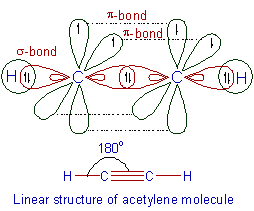
The following diagram summarizes the bonding pattern by carbon atom in different hybridizations.
No comments:
Post a Comment